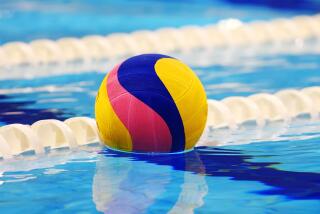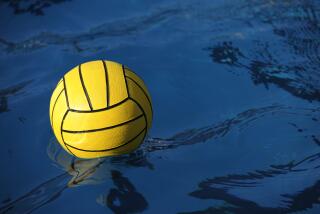Workout full of splash and dash
I’ve always been a certified land animal, despite having come from a family of competitive swimmers and water polo players. As my siblings competing in the deep end, I stayed on solid ground by running track in college. But all those hours of watching water polo from the sidelines made me curious about what type of workout I could get by actually trying the fast-paced sport.
On a recent Sunday afternoon, I pulled out my old Nike swimsuit and headed to the Rose Bowl Aquatic Center for a masters water polo scrimmage. It had been years since I had been in good enough swimming shape to sprint up and down the pool more than a few times.
By the 2:30 p.m. start time, seven players had gathered on the deck, changing into their swimsuits and chatting. I became increasingly nervous as more broad-shouldered men in Speedos joined the group. They looked like they had played a water polo game or two before.
The first thing I learned was the concept of “water polo time.” It would be a good 30 minutes of hanging around the pool deck and socializing before the game got underway. Charlie Wood Jr., a former water polo player at Princeton who started the weekly game a year ago, provided some last-minute pointers, teaching me how to guard my opponent by pushing down on his or her shoulder with my forearm, while putting my other hand in the air to block the pass. Then he threw me a white cap with lucky number 7.
By then, more than 20 players, including two other women, had arrived. I jumped in the water and joined a group of four men who were warming up, treading water as they passed the ball around. After 10 minutes, I was breathing hard and my legs burned from the continuous egg-beater movements necessary to stay afloat in 17 feet of water. Players are not allowed to let their feet touch bottom.
I sat on the sidelines with my team during the first game, as former college players squared off in front of the net, jostling for position and shooting powerful backhanded shots into the goal.
“They do all kinds of tricks -- they spin you and hold onto your suit to swim off, but it makes it fun,” said Garth Masik, 45, who took up the sport a couple of years ago. “It can definitely get heated.”
Finally, I was in the game. We played for 10 minutes, constantly sprinting up and down the pool on fast breaks, moving around the perimeter to set up our offense and passing the ball inside for a shot on goal.
Midway through our second game, I was grateful for a substitution. I was completely winded, and fortunately had escaped with only a couple of flutter kicks in the stomach.
Later, I got back in for five more minutes, feeling less energetic than before and definitely outmanned and overpowered: The two women I had mostly been guarding had left the game.
As I left the pool deck around 4:30, I felt drained but exhilarated. Though the players were far more experienced in water polo than I, they were easygoing and welcoming to a newcomer, offering tips such as how to turn your body to catch and throw the ball.
“You’re gonna sleep well tonight,” Wood called after me.
He was right. The next day there wasn’t a single muscle group that didn’t ache from the workout. My quadriceps and hamstrings were sore from treading water and sprinting up and down the length of the pool. My back and sides hurt from reaching to catch the ball and passing. My biceps were tired from the swimming, and even my hands were giving me trouble.
The Rose Bowl program focuses on recreation and having fun rather than on tournament competition, said Wood, 27, a Pasadena native who works as a Los Angeles County lifeguard. For his program, he requires players to be 18 years and older and recommends that they be strong swimmers and have some water polo experience at the high school level.
Mike Lewis, director of sport development for USA Water Polo, said the masters level (for players 20 and older) is one of the fastest-growing segments of the organization, attracting former college players and swimmers who want to take up the sport.
“I think water polo offers the benefits of swimming with the social aspect of, say basketball or soccer,” Lewis said. “So you have the cardiovascular benefits of swimming but then you get the technical, tactical and social aspects of a team sport, which makes it extremely unique.”
Lewis recommends that players have a strong swimming foundation and emphasizes the importance of establishing a good stretching routine, staying hydrated and cooling down after playing.
For older players, Lewis said, water polo is easier on the joints and muscles than land-based sports such as running.
“People just tend to love the sport, and once they get exposed to it, they’re hooked,” Lewis said.
Despite my initial fear of humiliating myself, I had a terrific time. I came away with a new respect for the sport, which looks graceful and effortless from the pool deck but is physical and relentless.
But with the physical exhaustion that came after two hours in the pool, I think I’ll stay on dry land for the time being.
*
For more information, contact Charlie Wood at cwood@alumni.princeton.edu. Entry to the pool facility is $10 per day or $20 per month. Rose Bowl Aquatic Center members can play for free. For other masters programs in your area, go to www.usawaterpolo.orgor call (719) 634-0699.

